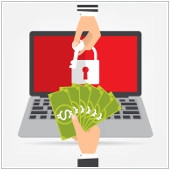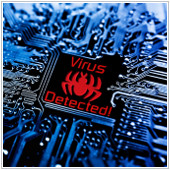 One of the biggest fears security experts have may be coming true: self-replicating ransomware. Viruses that have the ability to copy and spread themselves to new systems are nothing new, but until now ransomware attacks have been targeted campaigns. The best way to protect your network from a security threat is to understand it, here’s everything you need to know about this latest development.
One of the biggest fears security experts have may be coming true: self-replicating ransomware. Viruses that have the ability to copy and spread themselves to new systems are nothing new, but until now ransomware attacks have been targeted campaigns. The best way to protect your network from a security threat is to understand it, here’s everything you need to know about this latest development.
Ransomware, the malware that locks up infected systems and demands payment to return access to users, has been steadily increasing its infection rate over the course of this year. Enigma Software reported that, “After staying steady for the last six months of 2015, ransomware detection has begun to climb; February saw a 19 percent increase over January, while March had almost a 10 percent increase over February. Then, in April, infections more than doubled.”
And as if that wasn’t frightening enough, Microsoft announced last week that a recently detected ransomware software was found copying itself onto USB and network drives. The ransomware, titled ZCryptor, disguises itself as either an Adobe Flash installer or a Microsoft Office file to trick users into opening it.
Once opened, it displays a prompt that says “There is no disk in the drive. Please insert a disk into drive D:”. If you see this after opening a suspicious file, it is most likely ZCryptor trying to distract you while it works in the background to add a registry key that buries itself deep in your system and begins to encrypt your files.
Although previous ransomware iterations like Alpha Ransomware had the ability to find and encrypt files on shared network drives, security experts believe this is the first time a ransomware variant has included self-replication via removable drives into its framework.
When it was first detected in May, Microsoft found ZCryptor singling out 88 different file types for encryption. However, later on a security expert analyzed the ransomware and found 121 targeted file types — inferring that creators of the malware were continuing to develop its source code.
It’s commonplace for ransomware to demand payment to be made in Bitcoins as they’re an almost totally untraceable online currency. ZCryptor is no different, demanding 1.2 Bitcoins (500 USD) unless payment is more than four days after infection — then it increases to five Bitcoins (2,700 USD).
Compared to other more complex security threats, ransomware is still relatively easy to avoid. Always verify the source of email attachments and website downloads before opening files, disable macros in Microsoft Office programs, maintain regular backups and update your security software.
Still concerned about security at your SMB? It doesn’t have to be as difficult and draining as you may think. Contact us today for advice on keeping your network protected around the clock.



 As more and more content management services are released to aid SMBs in online marketing, security risks also increase. One such helper is the image processing service ImageMagick. And while it has proven useful to countless businesses, it is now something you should be concerned about from a security standpoint. Let’s take a minute to discuss this vulnerability and what you can do to protect yourself.
As more and more content management services are released to aid SMBs in online marketing, security risks also increase. One such helper is the image processing service ImageMagick. And while it has proven useful to countless businesses, it is now something you should be concerned about from a security standpoint. Let’s take a minute to discuss this vulnerability and what you can do to protect yourself.
 Why do hackers attack? Is it for money, notoriety, or political reasons? Many business owners never ask these questions, and instead only think about the means of how a cyber attack takes place. But knowing the motive behind a hacker’s attack can help you understand whether or not you’re a target and what data you need to protect. So let’s take a closer look at 4 different types of hackers and their motives.
Why do hackers attack? Is it for money, notoriety, or political reasons? Many business owners never ask these questions, and instead only think about the means of how a cyber attack takes place. But knowing the motive behind a hacker’s attack can help you understand whether or not you’re a target and what data you need to protect. So let’s take a closer look at 4 different types of hackers and their motives.
 In the 21st century, personal computing is with us wherever we go. This is all thanks to the proliferation of mobile devices such as smartphones and tablets. These devices allow us to take work home with us. And, with bring your own device (BYOD) strategy, businesses have never been so productive. However, BYOD poses a number of security risks if you’re not careful. What are these problems? How are they caused? Here are some BYOD security risks you should know before implementing it in your business.
In the 21st century, personal computing is with us wherever we go. This is all thanks to the proliferation of mobile devices such as smartphones and tablets. These devices allow us to take work home with us. And, with bring your own device (BYOD) strategy, businesses have never been so productive. However, BYOD poses a number of security risks if you’re not careful. What are these problems? How are they caused? Here are some BYOD security risks you should know before implementing it in your business.
 As companies go to the Internet to conduct their business, their IT security becomes more vulnerable to many hackers and viruses. That’s why it’s even more important to recognize whether or not your systems are under threat from malicious software to swiftly fend off the infection. So how do you know if your company’s IT security is under threat? Here are a few warning signs to tell if you are a victim of malware infection.
As companies go to the Internet to conduct their business, their IT security becomes more vulnerable to many hackers and viruses. That’s why it’s even more important to recognize whether or not your systems are under threat from malicious software to swiftly fend off the infection. So how do you know if your company’s IT security is under threat? Here are a few warning signs to tell if you are a victim of malware infection.
 When it comes to monitoring your employees online, there are potential positives and negatives for your company. But as a business owner who’s never done it before, you may be clueless as to what these are. So to help, we’ve come up with a list of the pros and cons of employee monitoring. And if you do decide to go through with it, we’ve provided some tips for a smooth implementation process.
When it comes to monitoring your employees online, there are potential positives and negatives for your company. But as a business owner who’s never done it before, you may be clueless as to what these are. So to help, we’ve come up with a list of the pros and cons of employee monitoring. And if you do decide to go through with it, we’ve provided some tips for a smooth implementation process.






 The threat of being infected by malicious software is part and parcel of spending time on the internet, and no sooner have the antivirus and security software programs released an update or new patch than cyber criminals are scrambling for ways to circumvent them. In addition, as end users become savvier to the tricks and scams used to steal our data, money or identities, new tactics are employed to try and fool us. And that includes Chimera, a new strain of ransomware which has recently been uncovered.
The threat of being infected by malicious software is part and parcel of spending time on the internet, and no sooner have the antivirus and security software programs released an update or new patch than cyber criminals are scrambling for ways to circumvent them. In addition, as end users become savvier to the tricks and scams used to steal our data, money or identities, new tactics are employed to try and fool us. And that includes Chimera, a new strain of ransomware which has recently been uncovered.